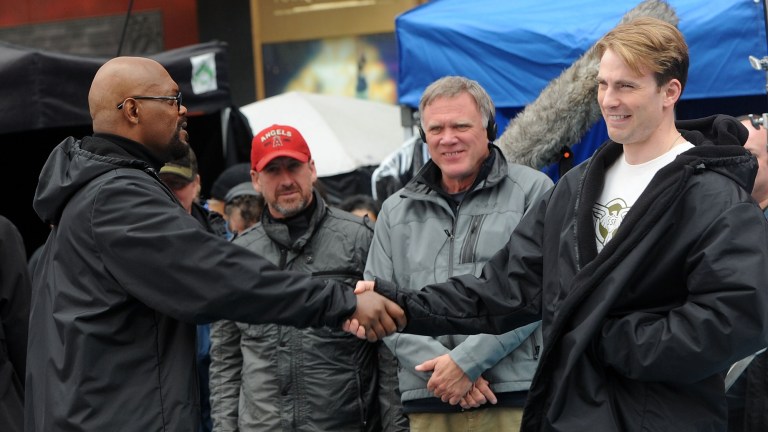Underrated Captain America Director Joe Johnston Deserves More Respect
Joe Johnston has made more than a few classics and generational touchstones, but his impact on Hollywood cinema seems somewhat overlooked.

Joe Johnston’s 1991 superhero movie The Rocketeer begins in the usual way, with orange opening credits against a black screen. Only the slight tinkling of piano hints at something greater, little notes of inspiration under the art deco script on display. Sure enough, after the title reveal, the score pauses. The black screen is revealed to actually be the doors of a hangar bay, and the strings in James Horner’s score rise to a crescendo. They are announcing the hopes hanging on the yellow biplane that emerges.
A warm, confident scene of pilot Cliff Secord (Billy Campbell) proving to his mechanic Peevey (Alan Arkin) and their pals that he’s got what it takes to win a race is an odd way to open a superhero movie, even one of the pulp-inspired films that Hollywood cranked out after Batman hit it big in 1989. By the end of The Rocketeer, though, viewers will not only see Secord don a golden helmet and leather jacket to go with his flying machine—a perfect adaptation of the character created by artist Dan Stevens in 1982—but also gangsters, Nazis, and Terry O’Quinn as Howard Hughes.
It’s great high adventure, but The Rocketeer still soars because it makes the audience care about the characters. And few directors understood the relationship between genre fiction and rich characters better than Joe Johnston.
Honey, I Became a Director
Johnston’s directing career began with a very different project. Inspired by 1950s sci-fi flicks such as The Incredible Shrinking Woman, director Stuart Gordon and Brian Yuzna traded gross-out flicks like Re-Animator and From Beyond with Teenie Weenies for Disney. But when illness forced Gordon to drop out of the project, Disney took a flier on a longtime special effects and designer, letting Joe Johnston jump right into directing a special-effects-heavy feature, now retitled Honey, I Shrunk the Kids.
The decision to pick Johnston wasn’t quite the gamble that the above context might suggest. Johnston has been in the industry since working as a visual effects artist (and uncredited stormtrooper) on Star Wars in 1977. Johnston went on to be a key designer in several sci-fi projects over the next few years, working as art director on Return of the Jedi and Indiana Jones and the Temple of Doom, and designing iconic characters such as Boba Fett and the Iron Giant. Johnston even worked as a second unit director on 1987’s *batteries not included, which featured Brad Bird as co-writer.
In other words, Johnston helped create some of the most influential films of all time, works that combined the spirit of wonder of the 1930s, ‘40s, and ‘50s into the special effects-driven spectacles of the ‘70s and ‘80s. More importantly, Johnston learned perhaps the greatest lesson that Steven Spielberg taught moviegoers: effects only matter if we care about the people being awed by them.
Johnston demonstrates his understanding of the relationship between character and spectacle in 1989’s Honey, I Shrunk the Kids. In one of the movie’s standout sequences, the pairs of protagonist siblings—Amy and Nick Szalinski (Amy O’Neill and Robert Oliveri) and Russell and Ron Thompson (Thomas Wilson and Jared Rushton)—try to summon a dog to carry them back home after they’ve been diminished to a few inches tall by a shrink ray. The camera follows the quartet through fantastic sets that turn grass and weeds into towers, showing off remarkably believable images. Instead of letting the effects overwhelm the scene, Johnston holds his camera for just a moment, as an embarrassed Russell tries to join the others in whistling for the dog, hoping that Amy doesn’t see his shortcomings.
It’s a two-second pause in a moment otherwise about adventure and spectacle. But Johnston knows those two seconds make everything else in the sequence matter.
An Awesome Career
Most of the eleven movies in Johnston’s filmography (counting The Pagemaster and The Nutcracker and the Four Realms, which he only partially directed) combine special-effects spectacle with moving character drama.
Before it became a lazy star vehicle for the Rock and Kevin Hart, the first Jumanji made time for teen Alan Parrish (Robin Williams) to lament his lost childhood in between the rhinos and monkeys emerging from a magical and ominous board game. Detractors fixate on the talking raptor meme created by Jurassic Park III, but Johnston not only crafted terrifying scenes of a pterodactyl attack but also rich interactions between a couple in a failing marriage (William H. Macy and Téa Leoni). Even Johnston’s misfire The Wolfman, a Universal gothic horror film hampered by an inert script and studio mishandling, has its notable sequences, including one of Benecio del Toro’s lycanthrope hunting Emily Blunt through the woods.
Perhaps the most famous example of Johnston’s talents comes with Captain America: The First Avenger from 2011. While Chris Evans (rightly) garnered a lot of praise for his ability to make Steve Rogers earnest without being hokey, Johnston was just as instrumental for pulling off that move in the character’s pivotal movie introduction. Johnston bathed the movie in sepia-toned nostalgia and kept things from getting cheesy thanks to great casting, which includes not only Evans but also Hayley Atwell as Peggy Carter and Tommy Lee Jones as General Chester Phillips. Their no-nonsense response to the proceedings combined with Evans’ goodhearted hero to keep things grounded in emotion, even when repurposing tropes from adventure serials (or, the Spielberg and George Lucas reimagining of adventure serials, anyway).
But Johnson’s most personal movie is the one with the least amount of spectacle yet the most character. Set in the late 1950s, October Sky follows the dreams of West Virginia teen Homer Hickam, played by a wide-eyed Jake Gyllenhaal, who wishes to escape his fate as a coal miner. Instead he yearns to become a rocket scientist. Johnson adapts Hickam’s autobiography but does so by tempering the nostalgia with real characters and exciting sequences.
Hickam’s disapproving coal-miner father could easily slip into cliché, even when played by the great Chris Cooper, but Johnston is careful to emphasize the man’s inner conflict and fundamental decency. In an early scene, Homer arrives at the coal mine right after a collapse. “That’s my dad,” beams Homer as the elder Hickam bravely drags a man out of the rubble. But when Mr. Hickam berates that same man for a mistake that caused the collapse and put others in danger, Homer’s face drops a bit and he repeats the line with less enthusiasm: “That’s my dad.”
With that one short scene, Johnston tells viewers everything they need to know about the two Hickam men. That tension sets up the more fantastic and traditional adventure sequences in the film, including a daring and comic scene in which Homer and his pals steal a piece of track from a line they thought abandoned only to hear an oncoming train. When October Sky does make its few indulgences with spectacle, mostly involving Homer testing the rockets he sends into the sky, Johnston pays homage to his mentor Spielberg with reaction shots of people looking up in awe.
The Fantasy of the Flying Man
The climax of The Rocketeer brings all the pieces Johnston is so adept at together. Now in full regalia, Cliff rockets to a zeppelin to rescue his girlfriend Jenny (Jennifer Connelly) from actor and fascist Neville Sinclair (Timothy Dalton, doing his best Errol Flynn). Gangsters and G-men join forces against the Nazi soldiers who have infiltrated Hollywood by force, creating a sequence that combines every trope of the ‘30s and ‘40s into one delightful romp.
But the payoff comes when floodlights point at Cliff. Bathed in light, Cliff strikes a heroic stance straight from Stevens’ illustrations, with a raised pistol in one hand, the fin of his helmet arched back, and an American flag billowing behind. Johnston holds on the image for a moment to let us drink it in but then cuts back to the awed people on the ground.
That moment is Johnston in a nutshell: fantastic images and emotional truth, qualities missing from too many movies, and qualities that should earn Johnston more praise.

